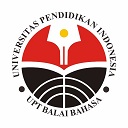Kumori: Teaching Media for Interactive Japanese Language Learning
Abstract
This paper centers around the ideas of developing students' media literacy through integrating Japanese language learning and multimedia form. This media is utilized to facilitate Japanese irregular verbs (Doushi) learning on the basis of morphological changes. One of Japanese verb forms which is employed frequently are words which have suffix -te, for they are use ask, order and allow interlocutors to do something (-te kudasai); to show present activities (-te imasu), to give permission (-temo ii desu); and to show prohibitions (-tewa ikemasen). Preliminary study elucidated that students found these Doushiare problematic and complex; thus, additional learning media to learn autonomously is inevitable for students to practice outside the classroom tasks. Researchers attempt to achieve this by developing appropriate teaching media by using Macromedia Flas8 software based on ADDIE model research and design steps, including Analysis, Design, Development and Implementation, Evaluation. The media is called Kumori, which provides interactive and meaningful media for student self-directed learning. The findings shows that Kumorias the instructional media in learning Japanese vocabulary which follows steps of the ADDIE model in order to produce an effective and efficient instructional tool for language learning, can give positive impact to students’ academic achievement. Therefore, adopting an appropriate instructional model must because it is a systematic process in developing proper instructional materials for an effective education and training program. Further, Kumorialso expected to able to contribute and implicated in Japanese language teaching and learning.
Keywords
Full Text:
PDFReferences
Alvermann, D.E., & Hagood, M.C. (2000). Fandom and Critical Media Literacy. Journal of Adolescent & Adult Literacy, 43(5), 436-446.
Brown, H. D. (2000). Principles of Language Learning and Teaching. New York: Addison Wesley Longman, Inc.
Decarrico, S. J. (2001). Vocabulary Learning and Teaching. In Celce-Murcia, M. (Ed.), Teaching English as a second or foreign language (3rd ed.). USA: Heinle & Heinle.
Dvorghets, O. S. & Shaturnaya, Y. A. (2015). Procedia - Social and Behavioral Sciences, 200: 192 – 198.
Jakarta Post. (2013). Retrieved from: https://www.thejakartapost.com/news/2013/07/15/indonesians-beat-koreans-become-no-2-learning-japanese.html
Gagné, R. M., Wager, W. W., Golas, K. C., & Keller, J. M. (2005). Principles of Instructional Design (5 ed.). USA: Thomson Wadsworth.
Geske, A., & Ozola, A., (2008). Factor Influencing Reading Literacy at the Primary School Level. Problems of Education in the 21st Century. 71-77.
Gall, M. D., Gall, J. P., & Borg, W. R. (2003). Educational Research an Introduction (7th ed.). Boston Allyn & Bacon.
Hattie, J., Timperley, H. (2007). The Power of Feedback. Rev. Educ. Res., 77: 81-112.
Horst, M., Cobb, T., Nicolae, I. (2005). Expanding Academic Vocabulary with an Interactive On-line Database. Languange Learning Technology, 9: 90-110.
Hung, H., Yang, J. C., Hwang, G., Chu, H., & Wang, C. (2018). A Scoping Review of Research on Digital Game-Based Language Learning. Computers and Education, 126: 89-104.
Hirschel, R. & Fritz, E. (2013). Learning vocabulary: CALL Program Versus Vocabulary Notebook System , 4: 639-653.
Japan Foundation. (2016). Survey Report on Japanese-Language Education Abroad 2015. Retrieved from: https://www.jpf.go.jp/j/about/press/2016/dl/2016-057-1.pdf
Katwibun, H. (2014). Procedia - Social and Behavioral Sciences, 1166: 74 – 678.
Kritikou, Y., Stavroulaki, V., Paradia, M. & Demestichas, P. (2010). User-oriented Web-based Learning Management Systems for Enhanced Vocabulary Teaching. Procedia Social and Behavioral Sciences, 9: 473-479.
Leu, D. J., & Kinzer, C. K. (2003). Effective Literacy Instruction, K-8. (5th ed.). Pearson Education.
Manion, A. (2005). Discovering Japan: Anime and learning Japanese culture. (Unpublished master’s thesis), University of Southern California.
Nakata, T. (2008). English Vocabulary Learning With Word Lists, Word Cards and Computers: Implications from Cognitive Psychology Research for Optimal Spaced Learning. ReCALL, 20: 3-20.
Reiser, R. A. & Dempsey, J. V. (2007). Trends and Issues in Instructional Design and Technology. New Jersey: Merrill Prentice Hall.
Simpson, R., & Obdalova, O. (2014). New Technologies in Higher Education –ICT Skills or Digital Literacy? Procedia –Social and Behavioral Sciences, 154: 105-111.
Sagarra, N., Zapata, G.C. (2008). Blending Classroom Instruction with Online Homework: a Study of Student Perceptions of Computer-Assisted Learning. ReCALL, 20: 208-224.
Uzunboylu, H. and Koşucu, E. (2017). Comparison and Evaluation of Seels & Glasgow and Addie Instructional Design Model. International Journal of Science and Research, 73(6): 98-112.
Eynon, R. (2010). Supporting the ‘Digital Natives’: What is the Role of Schools?: Proceedings of the 7th international conference on networked learning 2010, ed.L. Dirckinck-Holmfeld, V. Hodgson, C. Jones, M. de Laat, D. McConnell, and T.Ryberg, 851–8. Lancaster: Lancaster University.
DOI: https://doi.org/10.17509/japanedu.v4i2.18060
Refbacks
- There are currently no refbacks.
Copyright (c) 2019 JAPANEDU: Jurnal Pendidikan dan Pengajaran Bahasa Jepang

This work is licensed under a Creative Commons Attribution-ShareAlike 4.0 International License.
 Published by:
Published by: Department of Japanese Language Education, Faculty of Language and Literature Education
Universitas Pendidikan Indonesia
 Online ISSN: Online ISSN:2528-5548 |

JAPANEDU: Jurnal Pendidikan dan Pengajaran Bahasa Jepang (e-ISSN:2528-5548) lisenced under a Creative Commons Attribution-ShareAlike 4.0 Internasional (CC BY-SA 4.0)

